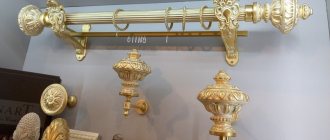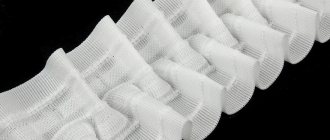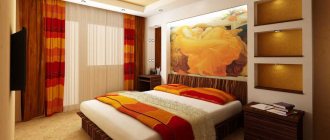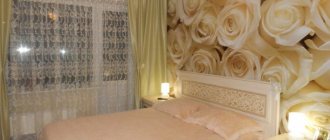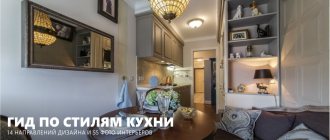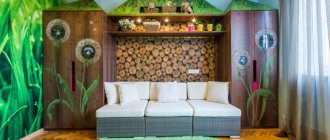Historical reference
It is believed that the thin, weightless fabric that hides your home from prying eyes owes its origin to the bride of the French king. According to legend, the girl was so embarrassed by the looks of numerous onlookers at the upcoming wedding that she asked the king to order a fabric for the veil so that it would hide the girl from prying eyes, but the bride herself could clearly see everything around her.
The king fulfilled his wish, the weavers came up with the fabric that we know as tulle. The court liked the fabric so much that they began ordering window curtains from the new fabric. At the French court, the fashion was picked up in other countries. Modern tulle is made from other materials, but the meaning remains the same.
Types of products
The design of tulle curtains in the bedroom is very important, but the material from which they are made is equally important.
Today, tulle is produced from materials of various qualities:
Voile is an elite fabric. This is a light and pleasant material, it consists of interlacing meshes that form patterns. Lets in enough light. It looks great on grommets and smooth cornices, but is not suitable for soft drapery, it puffs up a little.- Kisey is a young fabric, but thanks to its inimitability, it has gained popularity among consumers. Sometimes available in the form of thread curtains.
- Organza is a transparent, dense textile similar to silk, produced with ready-made decor. Usually decorated with embroidery, printing or spraying. Due to its compactness, it protects well from drafts and cold air from the window. Doesn't wrinkle well.
- Viscose is a common decor. Looks good, but heavy and very wrinkled. Due to the polyester added to the composition, colored patterns can be applied to the product.
- Mesh is an artificial fabric whose structure is made up of cells of different sizes.
- Silk - belongs to the elite, is made from natural fibers.
Functional load
Tulle is widely used to create curtains due to its ability to transmit light and air well. Beautiful tulle in the bedroom will not only hide you from prying eyes, but will also add lightness to the interior. In addition, tulle can hide the imperfections of a window opening and visually align the geometry of the room.
If your bedroom has a lot of reflective surfaces, the light passing through the patterned tulle will create beautiful patterns. This will bring some zest to your bedroom.
Advantages and disadvantages
Let's start with the disadvantage of this fabric, because there is only one. The fact is that even thick tulle will not give the room 100% darkness. Therefore, if you are hypersensitive to light and sleep only in complete darkness, you should think about combined curtain options.
In other situations, tulle is the most popular option, which is suitable:
- every style direction - from classics to super-fashionable trends;
- rooms with any subject content and amount of decor;
- both spacious and small rooms;
- windows of various heights and widths.
And everything written will be confirmed by these photos of examples of tulle in the bedroom interior:
And you don't have to worry about the material being translucent. The fabric called “tulle” was invented precisely because the French monarch wanted to observe everything that was happening without being noticed.
However, if in doubt, use two types of tulle to decorate the window - this is now fashionable, or complement light curtains with non-transparent curtains.
But there is one caveat - long thick curtains are less versatile. For example, it is believed that they are not suitable for low rooms, because... tend to burden the interior. Tulle, in turn, will unobtrusively add lightness and airiness to a room of any size.
Its obvious and undeniable advantages include a variety of colors, textures, cuts, shapes, pictures, images, etc. However, we have not yet reached the design of curtains and accessories, which expand such an assortment to infinity.
Let's take a closer look at several of the most popular types of tulle.
Materials
Now there are many variations of tulle made from artificial and mixed fabrics. Let's look at the most popular of them.
Tulle is a light, translucent, but quite rigid material. It is more suitable as an additional layer for a softer and more delicate tulle.
Viscose is an artificial fabric. It is distinguished by its lightness, variety and fragility. This disadvantage is compensated by the low price of the material.
The veil is made from cotton threads that are tightly intertwined. Very soft and lightweight fabric. It allows air to pass through well, but due to its natural origin it gets very dusty and requires frequent washing.
Organza is best suited for making curtains. Despite its transparency, it is a very durable fabric. Organza can be made from natural silk threads, polyester or viscose; the cost of the product depends on the threads.
Types of material
At the very beginning of the production of tulle fabric, it was made from linen, silk or cotton. The material looked impressive, but costs a lot of money. With the development of technology, the manual component of weavers' labor was replaced by a machine one, which significantly reduced the cost of finished products. The spread of synthetics has not spared tulle - now this material has a huge variety of colors and patterns, but anyone can afford it. Tulle is made from polyamide, and embroidery is applied with it - the material is smooth and soft. It is worth paying attention to several main types of tulle.
Organza
A fabric with a slight oriental feel, made from silk, viscose or polyester. The material is quite hard to the touch, but has a good level of strength. There are two subtypes of organza:
- shiny;
- matte.
The material is changeable - at certain angles it can change its color. If the fabric is processed under a special press, the effect of wrinkles is obtained, which looks very impressive in modern interiors. For luxurious classics, coated organza is suitable, looking very solemn and elegant. This material is chosen for the bedroom because of its performance characteristics - the fabric does not wrinkle, does not shrink and does not require complex care methods. The finished canvas is so light and airy that it is actively used to decorate rooms in romantic styles.
Organza is decorated with various patterns - the more complex the application method, the higher the cost. The most luxurious material is silk organza with hand embroidery. Most often you can find patterns on a floral theme, but the variety of patterns is not limited to this. The color palette is huge, so you can choose curtains according to your desires. Can be used as independent curtains or in combination with thick curtains.
Veil
This type of fabric has a fine mesh structure, somewhat reminiscent of dense gauze. The veil is an elite material - it is usually made from natural cotton. The fabric is very pleasant and soft to the touch, has a delicate texture. Suitable for conservative and modern interiors, as it has a smooth matte surface. Sometimes designs are applied to the fabric by mechanical processing or hand embroidery. There are several important points to pay attention to.
- The fabric is difficult to care for, but in return it creates an amazing feeling of lightness and airiness in the room.
- The material is suitable for multi-layer drapery - thanks to its soft texture, flowing folds are obtained.
- Voile is a luxury fabric, so you should prepare for serious expenses.
The color scheme of the material is distinguished by delicate pastel tones, but a variety of effects are actively used when one color smoothly transitions into another. The “Carnival” veil model is widespread, when the bottom of a heavenly shade flows into the top of a snow-white color. In combination with smooth folds, the effect of sea waves is obtained, relevant for bedrooms in the Art Nouveau style. Dark shades of veils have also gained popularity - shades of bronze, ash and chocolate are in fashion.
Kiseya
Kissey fabric consists of many decorative threads. Such curtains do not protect from sunlight, but this is not their main purpose - thread curtains are used as an effective element of decor and zoning of space. The panel is classified as an original curtain; it will fit perfectly into modern and oriental interior designs. Synthetic threads are used to make muslin curtains, as they do not fade in the sun and are characterized by increased strength. This is important for those muslin models where the threads are less than 2 millimeters thick. Thread curtains from 3 to 10 millimeters thick are also made from natural materials, but such panels can wrinkle.
Criterias of choice
When choosing which tulle is best for the bedroom, consider first of all the shape of the window opening. It’s worth considering whether you want to cover only the window or the partitions near the window block with tulle.
Next, you should choose the color and design of the tulle for the bedroom. They should resonate with the design of the room.
If you often wash curtains and tulle, choose curtains made from artificial fabrics. Polyester and viscose tulle withstands frequent washing best.
Choosing the right color
Clothes for windows should differ in color from the general color scheme of the room or apartment, otherwise the curtains and the room will merge in color - the “effect of no windows.”
You may be interested in what kind of fabric is used for sewing bedspreads
Be responsible when choosing the color scheme of textiles. To create comfort and a special atmosphere, you need to give preference to warm shades - brown, orange, coral are suitable. For connoisseurs of coolness, blue, light blue, and emerald are recommended.
Variety of color
Wash
In order for your new tulle to last a long time, you need to care for it in the following order:
- Carefully shake off the dust from the tulle; it is better to do this outside.
- Before washing, soak the tulle in a baking soda solution for several hours, this will help preserve the color of the product.
- Wash tulle on the “delicate” cycle with an appropriate detergent.
- Never twist the tulle. After washing, you need to wring it out lightly and wait until the water drains.
- You need to rinse the tulle several times, the water should be warm.
- Some types of tulle look better after starching. To make the tulle shine, add a tablespoon of vinegar to the water while rinsing.
- You can iron tulle only in the “delicate” mode. It is better not to iron it at all, but to hang it on the window in a slightly damp state.
Care instructions
Almost every apartment has tulle curtains. Like any fabric, they collect dust well and acquire a yellow tint, especially if they are on the sunny side. If these signs appear, then it is urgent to take action.
Washing process
First, you should remove the tulle, shake the curtains well from dust, then soak in a soap solution with the addition of baking soda or salt at room temperature. The water in the container needs to be replaced 4-5 times , depending on the degree of contamination of the fabric.
You can’t rub it, you just need to squeeze it lightly with your hands and rinse. The last rinse must be done in cool, clean water. There is no need to wring out the fabric thoroughly; hang it wet to dry. Tulle dries quickly. Be sure to make sure that the folds do not stick together, as wrinkled areas may appear, which will be very difficult to smooth out.
How to determine tulle size
In order for the tulle to fall beautifully from the cornice in folds, you need to buy fabric twice as large as the width of your cornice. Depending on the style of the bedroom, it can be a short tulle in the bedroom, up to the window sill, not reaching the floor by 2-3 cm, or reaching the floor.
When choosing a size, you should follow the rules:
- There should be at least five centimeters left on the sides of the fabric for hems.
- If the width of the fabric does not suit you, buy two pieces of fabric and sew them together, the seam between the folds will not be visible.
- If your bedroom has two windows next to each other, it makes sense to hang one tulle in front of both. This technique allows you to visually enlarge the room.
- The length of the future tulle for the bedroom window is measured only after the cornice is installed.
- If you choose patterned curtains, take the fabric a little wider. This will allow the ornament to be evenly distributed.
Take measurements
Before you sew yourself or order curtains from a specialist, carefully take measurements from the window with a measuring tape. Ideally, measurements are taken after installing the cornice.
In the case of installing a wall curtain rod, wider curtains, there will be a distance between the extreme fasteners. At the same time, make an allowance for the fold of tens of centimeters. The allowance depends on the chosen curtain model.
Related article: Window decoration in the hall: recommendations for choosing tulle
To sew tulle, you need to take two or even three window widths, it all depends on the fabric. Length is the distance from the eaves to the floor.
When mounting cornices on the ceiling, measurements are taken similarly to the option described above. The only difference will be that the length is measured from the ceiling.
Color solution
The color of tulle plays a very important role in the bedroom. In addition to the general appearance of the room, it must maintain the correct psychological mood of the owners of the bedroom. After all, people spend at least eight hours a day in this room. The color scheme also affects the visual perception of the space of the room.
White tulle in the bedroom is almost a win-win option. The only case where it may be inappropriate is a completely white room. If all the furniture and walls of the bedroom are painted white, then together with white tulle the room will turn into something like a hospital ward.
Green tulle is not often found in bedrooms, but if it is light tulle combined with heavy curtains of a related shade, it will successfully highlight both fabrics.
The blue color greatly decorates the room only if there are warm colors in the interior too. Blue is a fairly cool color. Photos of new designs often show a combination of blue and warm shades of brown. This combination will immediately make your bedroom fashionable.
The blue color of the tulle is also balanced by the warm colors of the bedspread, pillow or furniture. Yellow and white harmonize well with blue. Together they bring to mind the sea.
To ensure that the window area does not stand out too much from the background of the room, designers advise matching curtains and tulle in the bedroom with the main pieces of furniture (sofa, bed or wardrobe).
Application in bedroom interior
Light tulle and curtains framed by windows combine perfectly with each other and perfectly complement the interior of any room. The current style of decoration involves multi-layered use, which uses textiles of different textures. The curtain, like tulle, plays an important role in these compositions.
The bedroom is a room in which there should be a feeling of peace and tranquility. The rule regarding curtains in the bedroom is that they should decorate the room and create a tranquil environment.
In this room it is allowed to hang transparent tulle material without the use of curtains only in private houses and on the upper floors. This is unacceptable on the lower floors, so it is necessary to select tulle and curtains to achieve complete harmony. This must be followed, since the materials have different textures and, naturally, colors.
Thanks to the wide range of fabrics, you can always choose any textile you like.
Combination with curtains
If you search on the Internet for photos of modern tulle ideas for the bedroom in 2020, most likely you will see a combination of tulle and curtains. In modern design, only Scandinavian interior style can do without curtains.
Almost any tulle can be combined with one type of curtain or another.
- Regular curtains made of heavy fabric go well with classic tulle; they will help dim the too bright daylight.
- Short tulle goes well with Roman or Japanese curtains on the windows.
- On the double cornice you can place thin tulle and a pompous lambrequin.
Bedroom without curtains
If you don’t want to hang thick curtains, then the second layer on the window can also be tulle. Only the second layer should be slightly denser than the main fabric. The tulle in a bedroom without curtains should be a little thicker than usual to shade the light a little if your bedroom faces the south side of the house:
- Curtains made of thick artificial tulle look great, hung on grommets (through iron rings).
- From fabric of the same density as the main tulle, you can make a weightless lambrequin.
- The romantic spirit of the bedroom will come with beautiful tiebacks, decorative cords and braid.
- Thread tulles on top of classic ones look original.
- You can hang two tulles of the same quality, but in contrasting shades.
- If you have a large bedroom, tulle with photo printing is acceptable.
Options for attaching to the cornice
You can conveniently and beautifully hang tulle on a cornice in different ways, for example, using loops, drawstring, braid, Velcro or ties, but the most popular are the mounting options listed below.
Eyelets
They are made from a variety of materials and are great for such lightweight fabrics. This simple option for mounting on a cornice, in combination with tulle, looks very original.
Rings
A variety of rings, differing in diameter, shape and size, are considered a very convenient and decorative way to attach curtains.
How to create beautiful folds
In order for the tulle not to look like gauze, it must have many uniform folds.
The easiest way to make beautiful drapery is curtain tapes. A special ribbon is sewn to the top of the tulle using two lines. Then special cords inside the tape are pulled together, forming beautiful folds that will not fall apart.
If you need wide, uniform pleats, such as for a second layer to replace curtains, choose tulle with built-in metal rings. A metal or wooden round cornice is threaded through them.
Tulle for Provence style
The Provence style has been on the list of the most popular styles for many years. Therefore, among the fashionable tulles of 2020 you can find curtains in this style.
Floral motifs add signature charm. They can be reflected in the color of the tulle; it can be in delicate shades of pink, blue or milky colors, or in a colored floral pattern on a white background. As part of the style, tulles made from natural fabrics without synthetic shine are used.
Tulle in a modern interior
Modern style has incorporated features from almost every other style. Therefore, when choosing tulle for a modern-style bedroom, you have a wide choice of colors and styles.
In addition to the classic options in different colors, Roman blinds made not from linen, but from tulle, look good in such interiors. They cover the windows from prying eyes and unusually frame this area of the bedroom.
Thanks to a wide selection of fabrics in specialized stores, any owner will be able to choose natural and synthetic tulle to suit their taste and budget.
Drapery
We create masterpieces from simple transparent or translucent fabric.
- The use of tiebacks, tapes, and magnets to create large horizontal folds.
- If the fabric is assembled into the shape of a bow or other unusual designs, they are secured with a stitch on top of the fabric.
- Airy lambrequins can be made from the same fabric as the main curtains. They will create the effect of gentle clouds for the relaxation room.
- Collecting tulle onto a ribbon. It is necessary to stitch a special tape onto the canvas and then, with a slight movement of the hand, collect it - you get uniform small folds.
- Using thread or tape along the curtain. Gathers the fabric into a tail shape. You should not make this option too long - usually they use short tulle up to the window sill.
